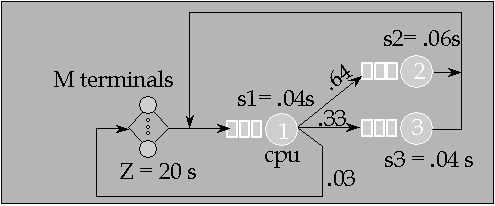Perf. Eval., Homework 3 (due 27.3.2002)
- The average delay experienced by a packet traversing a network is 100
msec. In average, the 128 packeages cross the network each second.
What is the average number of packets in transit? [Men94]
- Describe a situation where
- Improving the speed of one device will have no significant effect on overall system performance?
- Improving the speed of one device will have significant effect on overall system performance?
- Response time can not be made better with any small modification of the system?
- BJB bounds would be very good? What does "good" mean here?
- BJB bounds are not so good?
- [2 hwp] We have a new network controller card. It takes 0.05 ms CPU time
to process (interrupt handling, copy packet data buffer area in card to main
memory, switch back to interrupted process) each arriving packet. Maximum
incoming packet load is 10000 packets/sec. Assume for now that each packet
is fixed size, 512B. How big should the buffer size be so that the
likelyhood of buffer overflow would be less than 1 in a million? How
about less than 1 in 1000 millions? What about 10 times as fast processor?
- [2 hwp] Consider the ABA example in Lecture 6, and modify it slightly:

Just in case the fig does not print, s1=0.04 s (not 0.05), s2 = 0.06 s (not 0.08), s3=0.04 s, Prob(1,2) = 0.64 (not 0.55), Prob(1,3) = 0.33 (not 0.40), and Prob(1,terminals) = 0.03 (not 0.05). (Earlier version of this homework had erroneus s1=0.4)
What is the bottleneck device? What is maximum possible throughput?
With how many terminals the response time must be more than 10 secs?
Compute and draw ABA bounds for this system.
Teemu Kerola

